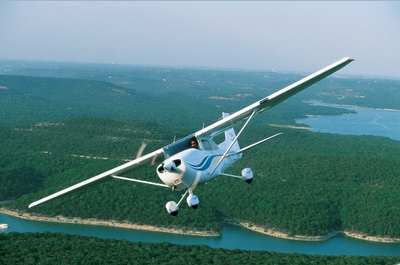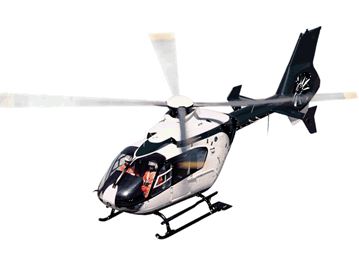NTSB Releases Factual Report From Collision Between A Cessna 172 And An EC-135 Medical Helicopter In VFR Conditions
The NTSB has released a factual report from a mid-air collision on December 31, 2010 which resulted in the fatal injury of two people aboard a Cessna 172. Witnesses told the board that the airplane may have been in an incorrect traffic pattern when it collided with a medical helicopter.

According to the report, a Eurocopter EC-135-P2 helicopter, N312PH, operated by PHI Inc., as AirCare 5, and a Cessna 172H, N2876L, collided in midair approximately 1/2 mile northwest of the Shenandoah Valley Regional Airport (SHD), Weyers Cave, Virginia. The airplane departed controlled flight after the right wing separated, and was destroyed by impact forces at ground contact. The helicopter sustained minor damage and landed safely at SHD. The certificated commercial pilot and passenger on board the airplane were fatally injured. The certificated commercial pilot and two medical flight crewmembers on board the helicopter were not injured. Visual meteorological conditions prevailed for the airplane's local personal flight that originated from SHD, at 1402, and for the helicopter’s positioning flight that originated from the University of Virginia Medical Center (8VA5), Charlottesville, Virginia, about 1410. A company flight plan was filed for the helicopter positioning flight, and no flight plan
was filed for the airplane flight. Both flights were conducted under the provisions of Title 14 Code of Federal Regulations Part 91.
All three crewmembers aboard the helicopter were interviewed at the scene, and their statements were consistent throughout. They described departing 8VA5 after completing a patient drop-off, crossing "the ridgeline" at 4,500 feet, and approaching SHD from the east. They each described monitoring the common traffic advisory frequency (CTAF), and how the announced traffic, two aircraft established in a left-hand traffic pattern for runway 23, were acquired both visually and on the helicopter's Skywatch traffic collision avoidance device (TCAD) system. The two crewmembers in the front seats correlated the landing-pattern traffic's announced positions both visually and on the TCAD. The third, aft-seated crewmember visually acquired the landing traffic based on their announced positions. The accident airplane was operating in the airport traffic area, but not in the established traffic pattern.

One flight nurse rode on the left side of the helicopter, behind the copilot's station, and faced aft. She stated that she was aware of two airplanes in the traffic pattern, one on "short final," the second airplane behind, and that the helicopter would be "the third aircraft to land." According to the flight nurse, "I was in the back under sterile cockpit procedures. Everyone was 'eyes-out' looking for traffic. I felt a bump and a shudder and the pilot said, 'What was that?'" She looked out and saw a white rectangle under the helicopter for "less than a millisecond."
A second flight nurse who rode in the copilot (left) seat gave a similar account, and stated that he had visual contact with the two airplanes that were also displayed on the helicopter's TCAD device. He added, "We were talking to all of them." The helicopter was in a gradual descent, and the nurse had visual contact with the airplanes on the base and final legs of the traffic pattern when he felt a bump. He reported that he never saw anything outside the helicopter at the time he felt the bump.
The pilot recalled routine radio communication as the helicopter approached SHD, as well as a radio call to request fuel upon landing. He described two airplanes in the traffic pattern: one on the downwind leg, and one on short final. The pilot followed behind and north of the second airplane and continued to the west side of the airport to complete a landing at the west side helipad. During the descent, about 500 feet above ground level, the pilot "saw about 2 feet of white wing right outside." He "pulled power" and then felt the contact.
All three crewmembers stated that the TCAD did not alert them to the accident airplane. They all described the crew coordination efforts to assess the damage to their aircraft, and the completion of a safe landing at the west-side helipad.
Witness interviews and written statements provided were largely consistent throughout. The witnesses were familiar with the airport, and with what they described as the usual traffic pattern of aircraft around the airport. Most of the witnesses described their vantage points as being 90 degrees from the direction of flight for both accident aircraft, and that the aircraft were traveling from roughly north to south. Most described the aircraft in level flight, with some differences as to whether the helicopter was on the airplane's left or right. Both aircraft were described as being "lower than usual," "awfully close," "almost even…next to each other." Consistently, witnesses described the helicopter as it overtook the airplane from behind, "barely touching" the airplane, and then watching as the right wing departed the airplane, and the remainder of the airplane "nose-dived" to ground contact.

In a written statement he provided along with photographs, one witness described the airplane as it approached the airport on the west side of the runway, and the helicopter's descent until the two aircraft collided. He added, "When I saw the airplane on the west side of the runway I found it kind of strange that it was there due to the fact that all the other airplanes were flying a left traffic pattern. I honestly had no idea why it was on this side of the runway. If it was trying to fly a right traffic pattern - it was going the wrong way."
In interviews with a Federal Aviation Administration (FAA) aviation safety inspector, pilots operating in the traffic pattern at SHD around the time of the accident said they recalled hearing various radio calls with regards to departures to the northwest, "maneuvering 6 miles to the northwest," and hearing the accident helicopter announce its position as it approached SHD. One pilot said he recalled hearing an airplane announce entering "upwind for runway 23" at SHD. All of the pilots stated that the traffic pattern at SHD was "unusually busy" around the time of the accident.
A pilot operating in the local flying area at the time of the accident said he had 15 hours of flight instruction from the pilot of the accident airplane, and that he would likely have recognized the instructor's voice over the radio had he heard it. He added that he distinctly recalled 3 separate position reports from the helicopter as it approached SHD, and standard traffic calls from airplanes in left traffic at SHD. He did not recall hearing a radio call that announced a non-standard entry, but added that the frequency was crowded on the day of the accident.
Radar data identified the accident helicopter by its assigned transponder code. The helicopter's ground track and altitudes were consistent with crewmember descriptions. The other radar targets were all depicted with the visual flight rules (VFR) "1200" transponder code. The number of airplanes that these "VFR targets" represented could not be reconciled.
(Cessna 172, Eurocopter EC-135 images from file. Not accident aircraft)
 Airbus Racer Helicopter Demonstrator First Flight Part of Clean Sky 2 Initiative
Airbus Racer Helicopter Demonstrator First Flight Part of Clean Sky 2 Initiative Diamond's Electric DA40 Finds Fans at Dübendorf
Diamond's Electric DA40 Finds Fans at Dübendorf ANN's Daily Aero-Term (04.23.24): Line Up And Wait (LUAW)
ANN's Daily Aero-Term (04.23.24): Line Up And Wait (LUAW) NTSB Final Report: Extra Flugzeugbau GMBH EA300/L
NTSB Final Report: Extra Flugzeugbau GMBH EA300/L Classic Aero-TV: 'Never Give Up' - Advice From Two of FedEx's Female Captains
Classic Aero-TV: 'Never Give Up' - Advice From Two of FedEx's Female Captains





